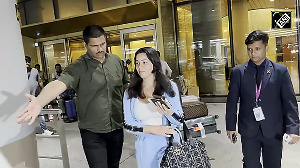The sign on the verandah of the building, on the outskirts of Delhi, announced it as a new air-conditioned office for registering property transfers -- inaugurated by the chief minister, no less.
There was only one problem: all those who were seated inside the air-conditioned rooms were the government's staff; the citizens who had come to get their property deals registered and to pay stamp duty had no choice but to hang out in the decidedly non-air-conditioned verandah while waiting for their turn to come.
Among the amenities on offer was a broken bench for those who could not stand for too long. There was no drinking water anywhere on the premises, nor a clean toilet in sight. But there was nary a word of protest from the scores of people who had come to deposit lakhs of rupees as stamp duties before registering the sale and purchase of their flats or houses.
The moral of the story: the government is the malik, you the taxpayer are the dumb cluck who must take what he gets while paying up. It is no different if you go to almost any village in the country -- the teacher in the local school is missing, the primary health centre is out of medicines, the power supply comes intermittently and at a hopelessly low voltage, you have to bribe the village patwari to check some land records But come election time and the political parties are promising the moon: free electricity, free meals, free loans (remember Devi Lal and Janardhan Poojary?) Welcome to the two views of the Indian state.
The traditional view is of the mai-baap state, one that does well by its citizens through "hand-out" politics. This handing-out of money falls into two broad categories: subsidies (on wheat, sugar, rice, kerosene, cooking gas, urea, exports, diesel ) and welfare programmes: free mid-day meals, free school education, old age pension, mostly free medical care in government dispensaries/hospitals et al.
But most of the subsidies have ended up going to the non-poor, while the programmes have been bedeviled by inefficiency and leakages. The result, as everyone knows, is a variety of unsatisfactory outcomes.
The alternative view of the state is as a provider of services to citizens, who take on the identity of consumers/users/beneficiaries of law and order, irrigation facilities, good public roads and smooth traffic flow, electricity, clean air, driving licences, property records, and so on.
The difference between the two views is that, in the first, the state is giving out freebies to dumb millions who have no real voice while, in the second, citizens acting as consumers expect a certain minimum quality of service -- like an air-conditioned waiting room to match the comfort given to the government babus dealing with your documents.
And it is easy to figure out who wants what: Chandrababu Naidu got lionised for being able to get you a driving licence in no time, or to produce your house tax records in a jiffy from a computerised database, but he got voted out nevertheless.
At the heart of many a political debate, and of many a policy debate, are these two views of the government: the mai-baap state and the service provider.
As the country slips into a new year, the defining reality about the relationship between the citizen and the state is the transition, however partial, from the first view to the second. In its own way, the transition has just found expression in the Gujarat elections, and it will be reflected again as 10 more states go to the polls this year, before the big test in 2009.
The first view is a top-down view; the second is more a contractual relationship: I pay my taxes, I expect some things in return. Increasingly, therefore, citizens will not take shoddy treatment without a murmur, they will protest and even go to the courts if their expectations are not met.
Of course, you are likely to protest only if you feel you have rights as a taxpayer. And if we want to define how many people might be inclined to the emerging view of the state, the cut-off point for paying income-tax is an annual income of Rs 1,50,000.
The number of families with that level of total income (which does not mean they all pay income tax!) is about 70 million, out of a total of some 210 million families. That first number will double in a decade, thus becoming more than half the total. Which inevitably means that the alternative view of the state is likely to become the dominant one before long -- and, as day follows night, this will bring about a fundamental shift in the relationship that the average Indian has with the state.
We could slice the numbers differently. For it so happens that the people living in towns and citizens see themselves more as consumers of services provided by the government, while those in the villages expect less from, and see less of, the government as they go about their daily lives.
Urbanisation in India has progressed slowly and is about 30 per cent (compared to 50 per cent for the world as a whole), but according to one estimate at least 40 per cent of all parliamentary constituencies already have a significant urban population, though not a majority. Ergo, the efficient provision of quality services at low cost matters more than before and you better be careful about what you promise the voter.
Digvijay Singh in Madhya Pradesh provided free schools to any village that asked for it, but he forgot about roads and power -- and was voted out of office. Narendra Modi in Gujarat boasted about the number of villages which he had provided with irrigation water and the sharp improvement in power supply, and was swept back into office.
In the first approach, governments have promised free electricity (another form of hand-out) but often delivered no electricity at all (poor service delivery), whereas Mr Modi actually raised power rates but guaranteed supply.
Karnataka is ahead of everyone else in improving ease of access to land records, Chidambaram has now promised a kinder, gentler tax department, Sheila Dikshit in Delhi talks of having improved air quality, and in Rajasthan, Vasundhara Raje is willing to guarantee electricity if a village promises to crack down on power theft. The signs are all around us that the substance of politics is changing.
In the broadest terms, and with all the appropriate qualifications, the Congress is even now oriented more to the vision of a mai-baap government -- although it was Rajiv Gandhi who 20 years ago talked of improving the telephone service, introducing computers, building better roads ; the BJP, in comparison to today's Congress, is more oriented towards effective service delivery. One appeals more to the poor, the other appeals more to the emerging middle class.
The big issue that the political parties will debate during 2008, in the run-up to the elections in 2009, will be which approach works better with the voter. If it proves to be the latter, then India will have marked the shift from the politics of poverty to the politics of the middle class. It will be nothing less than a tectonic heave.
Look at the United States, where every politician talks of the middle class, and the working family. There is very little focus on the poor -- though one-sixth of Americans cannot afford medical insurance, and one-eighth of the population is officially considered to be below the poverty line.
The American poverty line is, of course, different from India's: we define the line by the minimum required calorific intake, whereas the US defines it as three times the cost of a nutritionally adequate diet. But the operative point is that the search for the broader middle class vote has marginalised concern for the poor.
That has already begun happening in India. Notice how little the newspapers now focus on the poor, and how much they are oriented to treating citizens as consumers.
Governments in an earlier age would not have dared to try and move close to a million residents of Dharavi in order to make way for a second airport runway and for high-rises that will be an extension of the Bandra-Kurla financial centre.
Today, it is not considered an electoral risk to do just that. Note how governments elsewhere are willing to impose on poor landholders in order to make land available for industry, for special economic zones and the like, and how little sympathy there is for the poor who protest -- whether at Nandigram or in different places in Orissa. It is only when the protest includes the middle-class, as in Goa, that the government wants to scrap all SEZs in the state.
Indeed, when south Delhi protests at an overhead metro line spoiling cityscapes and creating noise pollution, the court lends a sympathetic ear despite the government protesting that an underground line will be three times as costly.
Welcome to the India of 2008.








 © 2025
© 2025